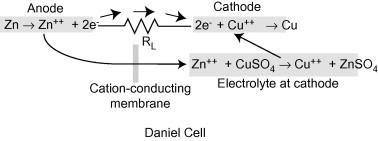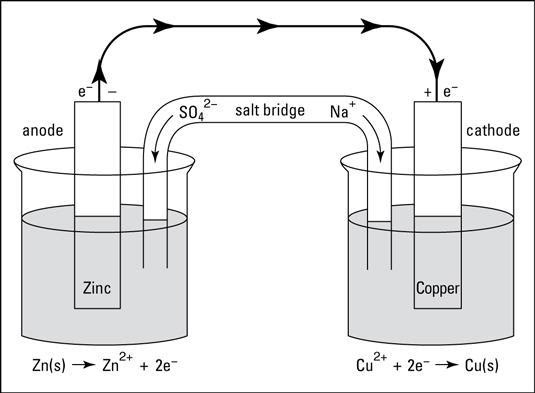Daniell Cell - Explanation, Diagram, Functions with FAQs

What is Daniell Cell, and how does it work?
The greatest example of a galvanic cell that turns chemical energy into electrical energy is a Daniell cell.
The Daniell cell is made up of two electrodes made of different metals, Zn and Cu, which are in contact with a solution of their respective ions, zinc sulphate and copper sulphate.
Also read -
- NCERT Solutions for Class 11 Chemistry
- NCERT Solutions for Class 12 Chemistry
- NCERT Solutions for All Subjects
NEET 2025: Mock Test Series | Syllabus | High Scoring Topics | PYQs
JEE Main: Study Materials | High Scoring Topics | Preparation Guide
JEE Main: Syllabus | Sample Papers | Mock Tests | PYQs
Daniell Cell in Chemistry Explanation
A conventional galvanic cell, it is meant to generate an electric current by using the spontaneous redox reaction between zinc and cupric ions.
A copper vessel makes up this cell. In this case, a saturated CuSO4 solution is used as a depolarizer and diluent. Fill with H2SO4, which works as an electrolyte. Zn2SO4 is used to submerge a zinc rod that has been amalgamated. CuSO4 crystals are kept in touch with CuSO4 solution by a transparent layer just below the upper surface of copper vessels, ensuring that the solution is always saturated.
Electrochemical cell: daniel cell images
Daniel cell diagram is given below.

Daniell Cell Process Steps:
Daniel cell working is discussed below.
Zn(s) + Cu2+(aq) ? Zn2++ Cu(s)
In a Daniell cell, electrons flow through an external circuit from zinc electrode to copper electrode to copper electrode, while metal ions move from one half cell to the other via the salt bridge.
Through an external circuit, current flows from the copper electrode to the zinc electrode, which is the cathode to the anode.
A voltaic cell can be reversible or irreversible, whereas a Daniell cell is reversible.
Reactions in Cells or Daniel cell reaction
Chemical Reaction of Daniell Cells
Daniel cell representation
Zn(s)+Cu+2? Zn+2(aq)+Cu+2(s)
The above reaction can be divided into two parts:
Half-cell anode reaction
Zn(s) ? Z+2+2e-
Zinc metal is oxidised once two electrons are liberated.
Reduction half-cell reaction
Cu2+ + 2e-(s) ? Cu(s)
Copper metal is formed when copper ions are reduced to copper metal
Also, students can refer,
- NCERT solutions for Class 12 Chemistry Chapter 3 Electrochemistry
- NCERT Exemplar Class 12 Chemistry Solutions Chapter 3 Electrochemistry
- NCERT notes Class 12 Chemistry Chapter 3 Electrochemistry
Daniell Cell Construction
It's made up of a copper container filled with a concentrated copper sulphate solution. One porous cylindrical pot filled with diluted sulphuric acid is immersed in the concentrated copper sulphate solution inside the container. In a porous pot, one amalgam zinc rod is immersed in dilute sulphuric acid. Sulphuric acid in its diluted state has positive hydrogen ions and negative sulphate icons, which is a feature of dilutes electrolytes.
When sulphate ions come into contact with zinc rods, they release electrons and generate zinc sulphate as a result of the oxidation reaction. As a result, the zinc rod acquires a negative charge and takes on the role of a cathode.
Positive hydrogen ions can pass through the porous wall of the pot and into the copper sulphate solution, where they combine with copper sulphate electrolyte sulphate ions to generate sulphuric acid. The positive copper ions in the copper sulphate electrolyte come into touch with the copper container's inner wall, where they are reduced and produce copper atoms, which are then deposited on the wall.
Related Topics, |
Daniell Cell's Operation
For a better understanding, let us go over the cell's operating concept step by step. In diluted sulfuric acid solution, there are H+ and SO4– – ions. The H+ ions come out to the copper sulphate solution through the wall of the porous pot. The sulphate ions of diluted sulfuric acid react with zinc rod where Zn++ ions get attached with SO4— ions and form zinc sulphate (ZnSO4). During this oxidation reaction, each zinc atom leaves two electrons in the zinc rod. Hence, the zinc rod becomes negatively charged that means it behaves as the cathode of the battery.
The hydrogen ions (H+) in the copper sulphate solution form sulfuric acid (H2SO4) and copper ions (Cu++) come to the wall of the outer copper container. By absorbing electrons from the container, copper ions deposit as copper metal on the container's wall. As a result, the copper container becomes positively charged, indicating that it serves as the Daniell Cell's anode. When an external load is connected between the central zinc rod and the peripheral copper container wall, electrons begin to flow from the zinc rod to the copper container.
Voltaic Cell Conditions
Because the external source's emf is greater than that of the voltaic cells, current can flow from the external source into the voltaic cell, reversing the cell reaction.
Current flows from the voltaic cell to the external source if the emf of the voltaic cell is greater than that of the external source.
Bridge made of salt
It preserves electrical neutrality in two compartments by allowing anions to travel towards anodic compartments and cations to move towards cathode compartments.
It's a gelatin-coated glass tube containing potassium chloride or ammonium nitrate.
Ionic mobility is permitted by the gelatin, but no mixing is possible.
When it comes to.
The Salt Bridge's Functions
Between the two half cells, a salt bridge serves as an electrical contact.
It restricts mechanical movement of solution but allows ions to migrate freely, allowing an electric current to pass through the electrolyte solution. It stops charges from building up.
The charge balance in the two half cells is maintained with the help of a salt bridge.
The liquid connection potential is reduced or eliminated by using a salt bridge.
Also check-
- NCERT Exemplar Class 11th Chemistry Solutions
- NCERT Exemplar Class 12th Chemistry Solutions
- NCERT Exemplar Solutions for All Subjects
NCERT Chemistry Notes:
Frequently Asked Questions (FAQs)
By consuming an electrode, the Daniell cell can be used to ‘generate' electricity or to ‘store' power.
Cell Daniell is the name given to it. Daniell's ingenious design isolated the copper and zinc ions from one another, preventing polarisation from blocking the electricity flow while allowing ions in the electrolyte to move between the two metals, completing the electrical circuit.
The Daniell cell is based on the redox reaction theory. Electrons can be transmitted as useful electrical current during the reaction cycle.
Daniell Cell Process Steps
Zn(s)+Cu+2? Zn+2(aq)+Cu+2(s)
In a Daniell cell, electrons flow through an external circuit from zinc electrode to copper electrode to copper electrode, while metal ions move from one half cell to the other via the salt bridge.
Through an external circuit, current flows from the copper electrode to the zinc electrode, which is the cathode to the anode.
A voltaic cell can be reversible or irreversible, whereas a Daniell cell is reversible.
Also Read
17 Dec'24 10:27 AM
12 Dec'24 01:16 PM
09 Jul'22 03:34 PM
08 Jul'22 03:43 PM
08 Jul'22 03:35 PM
08 Jul'22 03:32 PM
08 Jul'22 03:09 PM
08 Jul'22 03:03 PM
07 Jul'22 03:03 PM

